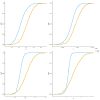Use of Danish National Somatic Cell Count Data to Assess the Need for Dry-Off Treatment in Holstein Dairy Cattle
- PMID: 37570331
- PMCID: PMC10416964
- DOI: 10.3390/ani13152523
Use of Danish National Somatic Cell Count Data to Assess the Need for Dry-Off Treatment in Holstein Dairy Cattle
Abstract
In Denmark, PCR testing of dairy cattle is commonly used to select animals for the antibacterial treatment of intramammary infection (IMI) during the dry-off period. IMI is associated with a high somatic cell count (SCC), routinely recorded for milk quality control for most commercial dairy herds. This study aimed to compare SCC curves over the lactation among dairy cows with positive vs. negative PCR test results for four major IMI pathogens. Data from 133,877 PCR-tested Holstein cows from 1364 Danish conventional dairy herds were used to fit a nonlinear mixed-effects model using a modified four-parameter Wilmink function. We stratified the data into first, second, third or fourth and later parity and fitted Wilmink curves to all SCC observations between 6 and 305 days in milk. The PCR tests were taken before dry-off at the end of the lactation to investigate which animals qualified for selective dry cow therapy. A PCR Ct-value of 37 and below was used to determine if an animal was PCR positive for any of the following IMI pathogens: Staphylococcus aureus, Streptococcus agalactiae, Str. dysgalactiae and Str. uberis. Our findings showed that mean SCC curve fits were higher for PCR-positive animals in all four parity groups and across lactations. The use of SCC data fitted to the entire lactation for multiple lactations enabled quantification of overall differences in SCC curves between cattle with and without detected IMI, adjusted for parity group and stage of lactation. These findings are relevant to the use of SCC to support treatment decisions.
Keywords: PCR testing; mastitis; wilmink function.
Conflict of interest statement
The authors declare no conflict of interest.
Figures




References
-
- WHO WHO—Antimicrobial Resistance. 2018. [(accessed on 6 June 2018)]. Available online: http://www.who.int/en/news-room/fact-sheets/detail/antimicrobial-resistance.
-
- European Commission . Animal Health Law 2016. European Commission; Brussels, Belgium: 2016.
-
- DANMAP . DANMAP 2019—Use of Antimicrobial Agents and Occurrence of Antimicrobial Resistance in Bacteria from Food Animals, Food And Humans in Denmark. Statens Serum Institute; Copenhagen, Denmark: 2019. [(accessed on 27 July 2023)]. Available online: https://www.danmap.org/reports/2019.
LinkOut - more resources
Full Text Sources
Research Materials

